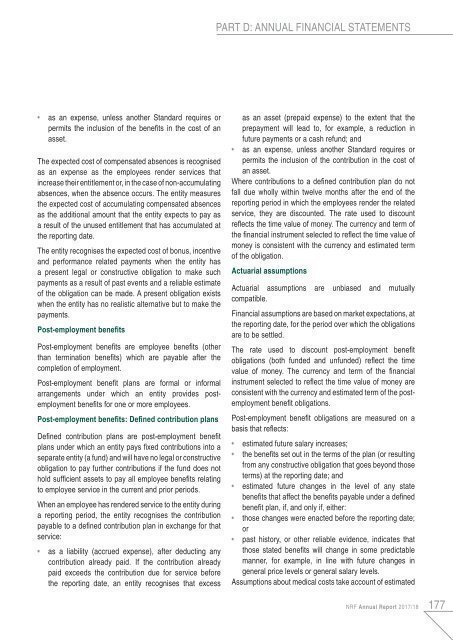NRF Annual Report 2018
Create successful ePaper yourself
Turn your PDF publications into a flip-book with our unique Google optimized e-Paper software.
PART D: ANNUAL FINANCIAL STATEMENTS<br />
• as an expense, unless another Standard requires or<br />
permits the inclusion of the benefits in the cost of an<br />
asset.<br />
The expected cost of compensated absences is recognised<br />
as an expense as the employees render services that<br />
increase their entitlement or, in the case of non-accumulating<br />
absences, when the absence occurs. The entity measures<br />
the expected cost of accumulating compensated absences<br />
as the additional amount that the entity expects to pay as<br />
a result of the unused entitlement that has accumulated at<br />
the reporting date.<br />
The entity recognises the expected cost of bonus, incentive<br />
and performance related payments when the entity has<br />
a present legal or constructive obligation to make such<br />
payments as a result of past events and a reliable estimate<br />
of the obligation can be made. A present obligation exists<br />
when the entity has no realistic alternative but to make the<br />
payments.<br />
Post-employment benefits<br />
Post-employment benefits are employee benefits (other<br />
than termination benefits) which are payable after the<br />
completion of employment.<br />
Post-employment benefit plans are formal or informal<br />
arrangements under which an entity provides postemployment<br />
benefits for one or more employees.<br />
Post-employment benefits: Defined contribution plans<br />
Defined contribution plans are post-employment benefit<br />
plans under which an entity pays fixed contributions into a<br />
separate entity (a fund) and will have no legal or constructive<br />
obligation to pay further contributions if the fund does not<br />
hold sufficient assets to pay all employee benefits relating<br />
to employee service in the current and prior periods.<br />
When an employee has rendered service to the entity during<br />
a reporting period, the entity recognises the contribution<br />
payable to a defined contribution plan in exchange for that<br />
service:<br />
• as a liability (accrued expense), after deducting any<br />
contribution already paid. If the contribution already<br />
paid exceeds the contribution due for service before<br />
the reporting date, an entity recognises that excess<br />
as an asset (prepaid expense) to the extent that the<br />
prepayment will lead to, for example, a reduction in<br />
future payments or a cash refund; and<br />
• as an expense, unless another Standard requires or<br />
permits the inclusion of the contribution in the cost of<br />
an asset.<br />
Where contributions to a defined contribution plan do not<br />
fall due wholly within twelve months after the end of the<br />
reporting period in which the employees render the related<br />
service, they are discounted. The rate used to discount<br />
reflects the time value of money. The currency and term of<br />
the financial instrument selected to reflect the time value of<br />
money is consistent with the currency and estimated term<br />
of the obligation.<br />
Actuarial assumptions<br />
Actuarial assumptions are unbiased and mutually<br />
compatible.<br />
Financial assumptions are based on market expectations, at<br />
the reporting date, for the period over which the obligations<br />
are to be settled.<br />
The rate used to discount post-employment benefit<br />
obligations (both funded and unfunded) reflect the time<br />
value of money. The currency and term of the financial<br />
instrument selected to reflect the time value of money are<br />
consistent with the currency and estimated term of the postemployment<br />
benefit obligations.<br />
Post-employment benefit obligations are measured on a<br />
basis that reflects:<br />
• estimated future salary increases;<br />
• the benefits set out in the terms of the plan (or resulting<br />
from any constructive obligation that goes beyond those<br />
terms) at the reporting date; and<br />
• estimated future changes in the level of any state<br />
benefits that affect the benefits payable under a defined<br />
benefit plan, if, and only if, either:<br />
• those changes were enacted before the reporting date;<br />
or<br />
• past history, or other reliable evidence, indicates that<br />
those stated benefits will change in some predictable<br />
manner, for example, in line with future changes in<br />
general price levels or general salary levels.<br />
Assumptions about medical costs take account of estimated<br />
<strong>NRF</strong> <strong>Annual</strong> <strong>Report</strong> 2017/18 177


